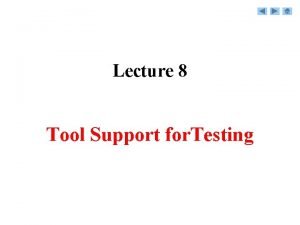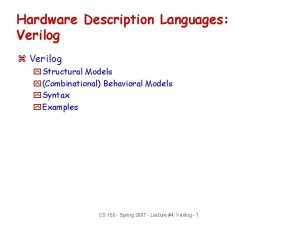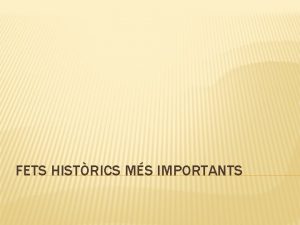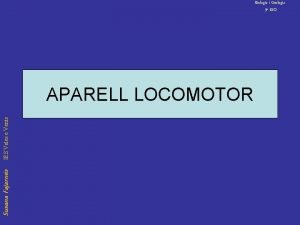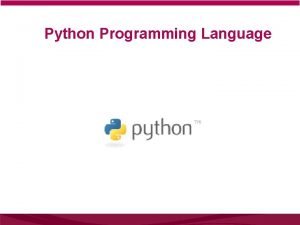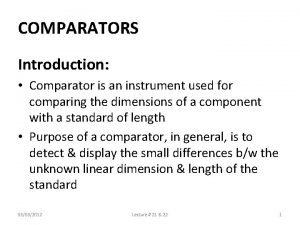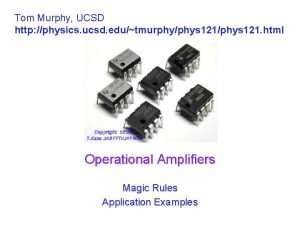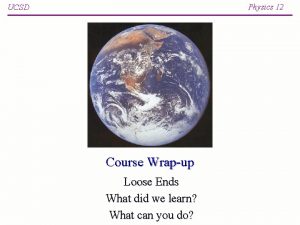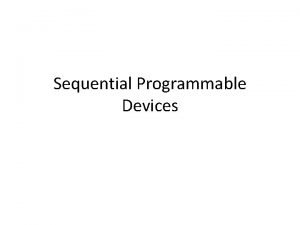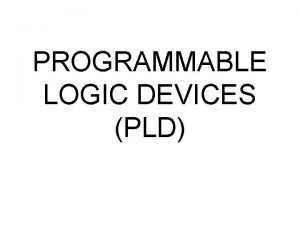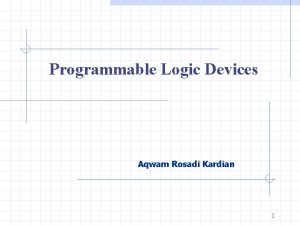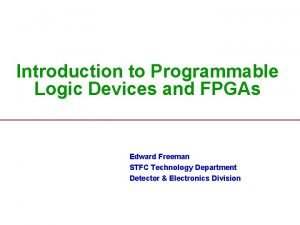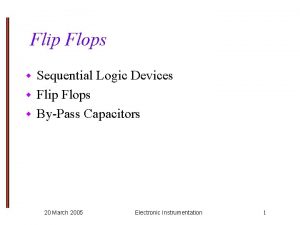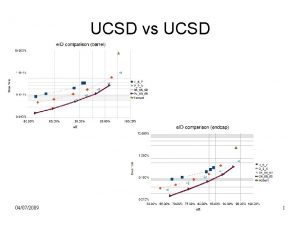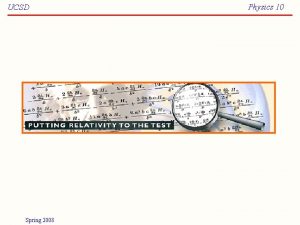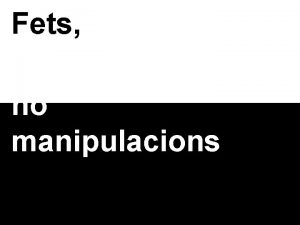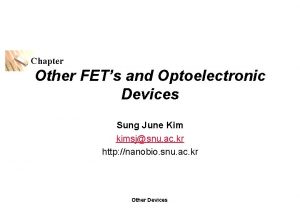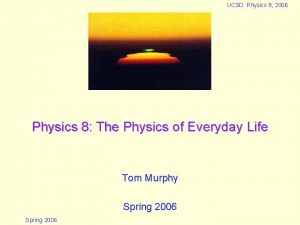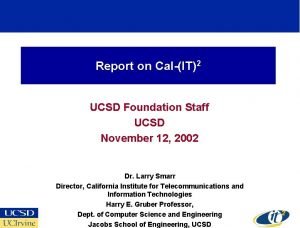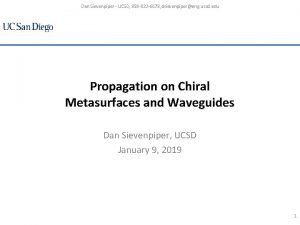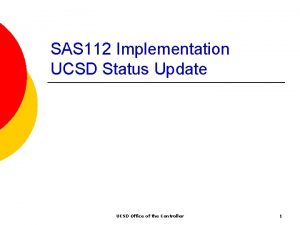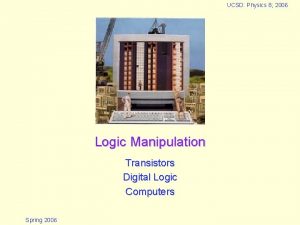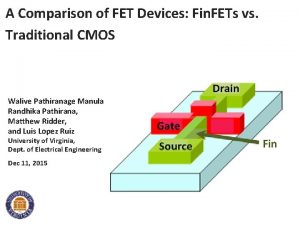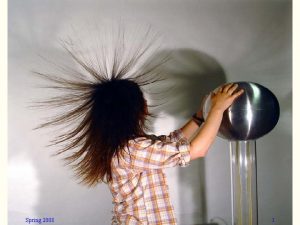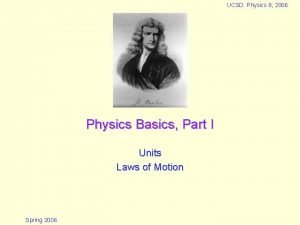Comparators FETS Logic Other Useful Devices UCSD Physics
























- Slides: 24

Comparators, FETS, & Logic Other Useful Devices

UCSD: Physics 121; 2012 Comparators • It is very often useful to generate a strong electrical signal associated with some event • If we frame the “event” in terms of a voltage threshold, then we use a comparator to tell us when the threshold is exceeded – could be at a certain temperature, light level, etc. : anything that can be turned into a voltage • Could use an op-amp without feedback – set inverting input at threshold – feed test signal into non-inverting output – op-amp will rail (negative rail if test < reference; positive rail if test > reference) • But op-amps have relatively slow “slew rate” – 15 V/ s means 2 s to go rail-to-rail if powered 15 V Winter 2012 2

UCSD: Physics 121; 2012 Enter the comparator +5 V Vin + Vref V R Vout 5 V Vout Vin Vref time • When Vin < Vref, Vout is pulled high (through the pull-up resistor— usually 1 k or more) – this arrangement is called “open collector” output: the output is basically the collector of an npn transistor: in saturation it will be pulled toward the emitter (ground), but if the transistor is not driven (no base current), the collector will float up to the pull-up voltage • The output is a “digital” version of the signal – with settable low and high values (here ground and 5 V) • Comparators also good at turning a slow edge into a fast one – for better timing precision Winter 2012 3

UCSD: Physics 121; 2012 Relays +5 V external circuit/load • Relays provide a way to switch on/off an AC line with a logic signal • Simple: 5 volts in AC switch flipped on • Often will phase to AC line so it turns on at zerocrossing, so-as not to jar electronics Winter 2012 4

UCSD: Physics 121; 2012 Opto-isolators 5 V Vin Vout • Optoisolators provide a means of connecting signals without copper (so can isolate grounds, noise, etc. ) – LED shines light on a phototransistor, bringing it into saturation – in the �above circuit, the output is pulled up to 5 V when the input is inactive, and drops near ground when the input sees a voltage Winter 2012 5

UCSD: Physics 121; 2012 Logic Families • TTL: transistor-transistor logic: BJT based – – chips have L, LS, F, AS, ALS, or H designation output: logic high has VOH > 3. 3 V; logic low has VOL < 0. 35 V input: logic high has VIH > 2. 0 V; logic low has VIL < 0. 8 V dead zone between 0. 8 V and 2. 0 V • nominal threshold: VT = 1. 5 V • CMOS: complimentary MOSFET – – chips have HC or AC designation output: logic high has VOH > 4. 7 V; logic low has VOL < 0. 2 V input: logic high has VIH > 3. 7 V; logic low has VIL < 1. 3 V dead zone between 1. 3 V and 3. 7 V • nominal threshold: VT = 2. 5 V – chips with HCT are CMOS with TTL-compatible thresholds Winter 2012 6

UCSD: Physics 121; 2012 Logic Family Levels • CMOS is closer to the “ideal” that logic low is zero volts and logic high is 5 volts – and has a bigger dead zone • The ? CT line accommodates both the TTL/CMOS levels • Example: A TTL device must: – interpret any input below 0. 8 V as logic low – interpret any input above 2. 0 V as logic high – put out at least 3. 3 V for logic high – put out less than 0. 35 V for logic low • The differing input/output thresholds lead to noise immunity Winter 2012 7

UCSD: Physics 121; 2012 Field-Effect Transistors • The “standard” npn and pnp transistors use basecurrent to control the transistor current • FETs use a field (voltage) to control current • Result is no current flows into the control “gate” • FETs are used almost exclusively as switches – pop a few volts on the control gate, and the effective resistance is nearly zero 2 N 7000 FET Winter 2012 8

UCSD: Physics 121; 2012 FET Generalities FET • Every FET has at least three connections: – source (S) • akin to emitter (E) on BJT – drain (D) • akin to collector (C) on BJT – gate (G) • akin to base (B) on BJT • Some have a body connection too – though often tied to source note pinout correspondence Winter 2012 9

UCSD: Physics 121; 2012 FET Types • • Two flavors: n and p Two types: JFET, MOSFETs more common JFETs conduct “by default” log current p-channel MOSFET n-channel MOSFET – when Vgate = Vsource • MOSFETs are “open” by default p-channel JFET n-channel JFET – must turn on deliberately • JFETs have a p-n junction at the gate, so must not forward bias more than 0. 6 V • MOSFETs have total isolation: do what you want Winter 2012 4 0 2 2 Vgate Vsource 4 10

UCSD: Physics 121; 2012 MOSFET Switches • MOSFETs, as applied to logic designs, act as voltagecontrolled switches – n-channel MOSFET is closed (conducts) when positive voltage (+5 V) is applied, open when zero voltage – p-channel MOSFET is open when positive voltage (+5 V) is applied, closed (conducts) when zero voltage • (MOSFET means metal-oxide semiconductor field effect transistor) drain source n-channel MOSFET gate p-channel MOSFET gate “body” connection often tied to “source” source + voltage 0 V Winter 2012 + voltage 5 V 0 V drain 5 V 0 V 0 V 5 V 5 V < 5 11 V

UCSD: Physics 121; 2012 Data manipulation A • All data manipulation is based on logic NOT • Logic follows well defined rules, producing predictable A C digital output from certain input 0 1 1 0 • Examples: AND AB 0 0 0 1 1 OR C 0 0 0 1 A B AB 0 0 0 1 1 C A B C 0 1 1 1 A B XOR NAND AB 0 0 0 1 1 C 0 1 1 0 A B NOR AB 0 0 0 1 1 C 1 1 1 0 C 1 0 0 0 A B bubbles mean inverted (e. g. , NOT AND NAND) Winter 2012 12

UCSD: Physics 121; 2012 An inverter (NOT) from MOSFETS: 5 V input 5 V A NOT A C 0 1 1 0 5 V output 0 V 0 V 5 V 5 V 0 V 0 V 0 V • 0 V input turns OFF lower (n-channel) FET, turns ON upper (p-channel), so output is connected to +5 V • 5 V input turns ON lower (n-channel) FET, turns OFF upper (p-channel), so output is connected to 0 V – Net effect is logic inversion: 0 5; 5 0 • Complementary MOSFET pairs CMOS Winter 2012 13

UCSD: Physics 121; 2012 A NAND gate from scratch: • Both inputs at zero: – lower two FETs OFF, upper two ON – result is output HI 5 V • Both inputs at 5 V: – lower two FETs ON, upper two OFF – result is output LOW IN A OUT C • IN A at 5 V, IN B at 0 V: – upper left OFF, lowest ON – upper right ON, middle OFF – result is output HI IN B • IN A at 0 V, IN B at 5 V: NAND – opposite of previous entry – result is output HI 0 V 0 V Winter 2012 A B C AB 0 0 0 1 1 14 C 1 1 1 0

UCSD: Physics 121; 2012 A NOR gate from scratch: just a NAND flipped upside-down… • Both inputs at zero: 5 V 5 V – lower two FETs OFF, upper two ON – result is output HI • Both inputs at 5 V: – lower two FETs ON, upper two OFF – result is output LOW • IN A at 5 V, IN B at 0 V: IN A OUT C – lower left OFF, lower right ON – upper ON, middle OFF – result is output LOW • IN A at 0 V, IN B at 5 V: IN B NOR – opposite of previous entry – result is output LOW 0 V Winter 2012 A B C AB 0 0 0 1 1 15 C 1 0 0 0

UCSD: Physics 121; 2012 All Logic from NANDs Alone NAND AB 0 0 0 1 1 C 1 1 1 0 AND NOT AB 0 0 0 1 1 A C 0 1 1 0 A B invert output (invert NAND) NOR OR invert both inputs C 0 0 0 1 AB 0 0 0 1 1 C 0 1 1 1 AB 0 0 0 1 1 C 1 0 0 0 invert inputs and output (invert OR) Winter 2012 16

UCSD: Physics 121; 2012 One last type: XOR A B C • XOR = (A NAND B) AND (A OR B) • And this you already know you can make from composite NAND gates (though requiring 6 total) • Then, obviously, XNOR is the inverse of XOR – so just stick an inverter on the output of XOR Winter 2012 17

UCSD: Physics 121; 2012 Rule the World • Now you know how to build ALL logic gates out of -channel and p-channel MOSFETs n – because you can build a NAND from 4 MOSFETs – and all gates from NANDs • That means you can build computers • So now you can rule the world! Winter 2012 18

UCSD: Physics 121; 2012 Arithmetic Example • Let’s add two binary numbers: 00101110 = 46 + 01001101 = 77 01111011 = 123 • How did we do this? We have rules: 0 + 0 = 0; 0 + 1 = 1 + 0 = 1; 1 + 1 = 10 (2): (0, carry 1); 1 + (carried 1) = 11 (3): (1, carry 1) • Rules can be represented by gates – If two input digits are A & B, output digit looks like XOR operation (but need to account for carry operation) XOR A B Winter 2012 AB 0 0 0 1 1 C 0 1 1 0 19

UCSD: Physics 121; 2012 Can make rule table: Cin 0 0 1 1 A 0 0 1 1 B 0 1 0 1 D Cout 0 0 1 1 0 0 1 1 1 • Digits A & B are added, possibly accompanied by carry instruction from previous stage • Output is new digit, D, along with carry value – D looks like XOR of A & B when Cin is 0 – D looks like XNOR of A & B when Cin is 1 – Cout is 1 if two or more of A, B, Cin are 1 Winter 2012 20

UCSD: Physics 121; 2012 Binary Arithmetic in Gates A B Cin E F D H G Input Intermediate A B Cin E F H G 0 0 0 0 1 0 1 1 0 0 1 0 0 0 1 1 1 0 1 1 1 Winter 2012 A B Cout Cin Cout + D “Integrated” Chip Output D Cout 0 0 1 1 0 0 1 1 1 Each digit requires 6 gates Each gate has ~6 transistors ~36 transistors per digit 21

UCSD: Physics 121; 2012 8 -bit binary arithmetic (cascaded) 0 0 1 1 1 0 + 0 + 1 + 1 0 + 1 + 0 0 0 1 1 0 MSB 11 00101110 = 46 + 01001101 = 77 01111011 = 123 Carry-out tied to carry-in of next digit. “Magically” adds two binary numbers Up to ~300 transistors for this basic function. Also need –, , , & lots more. 1 1 LSB = Least Significant Bit Integrated one-digit binary arithmetic unit (prev. slide) Winter 2012 22

UCSD: Physics 121; 2012 Computer technology built up from pieces • The foregoing example illustrates the way in which computer technology is built – – – start with little pieces (transistors acting as switches) combine pieces into functional blocks (gates) combine these blocks into higher-level function (e. g. , addition) combine these new blocks into cascade (e. g. , 8 -bit addition) blocks get increasingly complex, more capable • Nobody on earth understands Pentium chip inside-out – Grab previously developed blocks and run – Let a computer design the gate arrangements (eyes closed!) Winter 2012 23

UCSD: Physics 121; 2012 Reading • As before, The Art of Electronics by Horowitz and Hill, and the Student Manual accompaniment by Hayes and Horowitz are valuable resources • Text reading: – – – – p. 432 (p. 461 in 3 rd ed. ) on comparators 6. 2. 5 on relays (esp. solid state) pp. 461– 462 (490– 491 in 3 rd) paragraph on opto-isolators 6. 6. 10 on logic families p. 410 (p. 449 in 3 rd) on FETs 6. 6. 1, 6. 6. 2, 6. 6. 3, 6. 6. 4 on digital logic 6. 6. 7 on DACs, ADCs Winter 2012 24
 Tool support for testing
Tool support for testing If in verilog
If in verilog Histrics
Histrics Costelles vertaderes
Costelles vertaderes Control flow graph python
Control flow graph python Reed type comparator
Reed type comparator Ucsd physics
Ucsd physics Physics courses ucsd
Physics courses ucsd Tom murphy ucsd
Tom murphy ucsd Ucsd physics courses
Ucsd physics courses First order logic vs propositional logic
First order logic vs propositional logic First order logic vs propositional logic
First order logic vs propositional logic First order logic vs propositional logic
First order logic vs propositional logic Concurrent vs sequential
Concurrent vs sequential Tw
Tw 캠블리 단점
캠블리 단점 Combinational logic sequential logic
Combinational logic sequential logic Combinational logic sequential logic 차이
Combinational logic sequential logic 차이 Logic chapter 3
Logic chapter 3 Spld cpld fpga
Spld cpld fpga Fixed logic devices
Fixed logic devices Logic
Logic Logic devices for interfacing
Logic devices for interfacing Logic functions
Logic functions Multivabrators are logic devices cover
Multivabrators are logic devices cover
